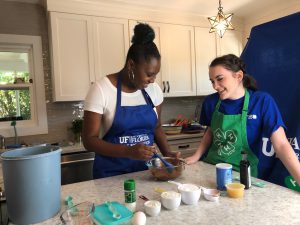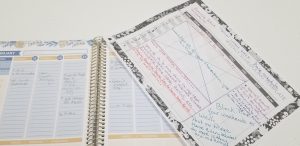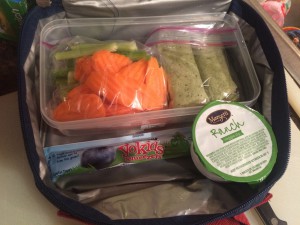by Rachel Pienta | Jan 21, 2022
 Healthy Living is one of the 4-H’s. While your club may not specifically focus on what is traditionally considered to be “healthy living” activities, you might be surprised about much your 4-H club is contributing to the mental and physical well-being of youth members. After we recognize that all our clubs have a role to play in implementing healthy living strategies across the county 4-H program, we can start to consider ways to be intentional in how we incorporate healthy living into 4-H activities and projects.
Healthy Living is one of the 4-H’s. While your club may not specifically focus on what is traditionally considered to be “healthy living” activities, you might be surprised about much your 4-H club is contributing to the mental and physical well-being of youth members. After we recognize that all our clubs have a role to play in implementing healthy living strategies across the county 4-H program, we can start to consider ways to be intentional in how we incorporate healthy living into 4-H activities and projects.
What does a 4-H Healthy Living program include? A 4 H Healthy Living program or strategy is any activity or program component that can help youth lead lives that balance physical, mental, and emotional health.
According to the National 4-H Council, 4-H Healthy Living programs include objectives that can help “empower youth to be healthy – body and mind – with the skills to make healthy decisions and lead healthy lifestyles. Having the confidence and skills to lead healthy lifestyles not only improves overall well-being; it enables youth to tackle life’s challenges today and become leaders in their lives, careers, and communities as they grow into responsible adulthood” (National 4-H Council, 2021). Your club focus might fit into one of the following program areas: mind, body, leadership, or mentorship.
As a club leader, you may encourage your youth to adopt goals and projects that will cover multiple program areas. Introducing healthy living during club meetings is another way to incorporate these concepts and help youth develop healthier habits.
With so many possible topics to consider, it may seem overwhelming to choose a starting point. In this article, a few suggestions will be explored.
Sleep
It may be surprising to learn that youth, like adults, are not getting enough sleep. Regularly missing hours of sleep or experiencing poor sleep quality can contribute to a variety of issues for youth. The Sleep Foundation is one resource to use for tips on how to encourage our 4-H members to adopt better sleep habits (Pacheco, 2021).
Some ideas for helping your 4-H youth learn about the importance of sleep and how to develop better sleep habits include the activities and lessons listed in the links below this paragraph. Consider challenging your youth to set healthy sleep goals for one month. Discuss the potential benefits during your goal setting activity. At the end of the month, discuss how youth felt on days when the sleep goals were met and how they felt on days when they did not meet their goal.
Activity for Teens (Intermediates and Seniors)
University of Wisconsin Extension. 2007. “4-H Get Fit, That’s It. Lesson 2: Are You Getting Enough Sleep.” Link to activity: https://api.ag.purdue.edu/api/DepotWS/File.ashx?t=f&i=98730
Activity for Elementary School Age (Juniors 4-H Members)
The Nemours Foundation. 2015. Sleep. Kids’ Health in the Classroom.
https://classroom.kidshealth.org/classroom/3to5/body/functions/sleep.pdf
Hydration
One way to incorporate a healthy living strategy into your 4-H program is offering water at all your meetings and limiting the inclusion of other beverages. A 4-H lesson on hydration can include STEM principles as youth can calculate their daily water needs based on their body weight. A fun way to encourage water consumption is to personalize reusable water bottles as a club activity and to award points to youth who remember to bring their bottles to meetings and activities.
All Ages Lesson and Activity
National 4-H Council.2020. How Much Water Do You Need? 4-H Healthy Living Activity Guide.
https://4-h.org/wp-content/uploads/2019/04/4H-Healthy-Living-Activity-Guide.pdf
Other Ways to Incorporate Healthy Living into Your Club Programs
Activities designed to improve sleep and hydration are only two of many possible ways to incorporate healthy living into your 4-H program. Healthy Living activities can incorporate exercise, nutrition, and ways to improve and maintain mental health.
Resources
Caruso, L.; Shelnut, K.; Kauwell, G. 2017. Hydration Myths. UF/IFAS Extension. Retrieved January 16, 2022 from https://edis.ifas.ufl.edu/publication/FY1409.
National 4-H Council. 2021. Healthy Living. Retrieved January 16, 2022 from https://4-h.org/parents/healthy-living/.
Pacheco, D. 2021. Children and Sleep. The National Sleep Foundation. Retrieved January 16, 2022 from https://www.sleepfoundation.org/children-and-sleep.
University of California 4-H Youth Development Program. 2022. Sleep for Better Living. Retrieved January 16, 2022 from https://4h.ucanr.edu/Projects/HealthyLiving/Sleep_for_Better_Living/

by pmdavis | Aug 9, 2019

Looking for spots missed during hand washing by using black light and glow germ lotion that fluoresces under black light.
It’s hard to believe it is August already, with that we are getting ready to go back to school. Going back into the large group gathering requires a reminder to wash your hands often. You and your child will be around so many people and exposed to all kinds of germs. Regular hand washing helps you avoid getting sick and spreading your germs to others.
The CDC recommends that we wash our hands:
• Before, during, and after preparing food
• Before eating food
• Before and after caring for someone who is sick
• Before and after treating a cut or wound
• After using the toilet or after changing diapers or cleaning up a child who has used the toilet or been ill
• After blowing your nose, coughing, or sneezing,
• After touching an animal, animal/pet feed or treats, or animal waste
• After touching garbage
Take a moment to sit down and talk with your child about hand washing and the importance of washing their hands, especially when they get home from school.
Try this activity written by Tennessee 4-H to help youth see where they may be missing germs. This simple activity uses items you probably have in your kitchen. Begin by coating hands with a tablespoon of cooking oil. Next, sprinkle the oily hands with ground cinnamon. Have your child wash their hands using the steps outlined below. Once they have finished washing, have them smell their hands to see if they can still smell cinnamon. If they washed their hands correctly, the cinnamon smell and brown color should be gone from their hands.

A. Hands coated with cinnamon before hand washing
B. Quick wash like youth often do missing in between fingers, top of wrist, around nails
C. Thoroughly washed hands (all clean even between fingers)
Here are the steps we teach youth when they take our 4-H hand washing classes:
1. Wet your hands with clean, running water.
2. Apply soap and rub your hands together to make a lather. Make sure to get in between your fingers, under your nails, and on the top of your hands. Youth often miss these areas when we do a lesson on hand washing during 4-H events.
3. Scrub for at least 20 seconds—about the same amount of time needed to sing the Happy Birthday or ABC Song twice.
4. Finish by rinsing your hands with warm running water.
5. Dry hands with a clean towel or let air dry if a towel is not available.
6. Use the towel to turn off the water faucet to prevent re-contamination of your clean hands on a dirty faucet knob.
Have a fun and germ free day! 4-H is a family affair, offering many opportunities where both children and parents can participate in common interests. 4-H is one of the nation’s most diverse organizations and includes people from all economic, racial, social, political, and geographic categories. There are no barriers to participation by any young person. Participants are given the opportunity to engage in activities that hold their personal interest, while being guided by adult volunteers.
To find out more information about other 4-H programs like this or volunteer your time to work with youth, please contact your local UF IFAS County Extension Office.
by Yolanda Goode | Mar 15, 2019

Are you physically or mentally running on E?
Are you racing “90 to nothing” in your daily life? until something forces us to hit the brakes or the emergency brake is applied. Instead of clearing our plates, we add sideboards onto them so that we can accept more.
We wear many hats outside of work such as a family member, caregiver, volunteer, student, etc. Some days we find ourselves in foul moods where we lack comprehension, patience, and focus. Is it because we are hangry (hungry + angry) or just plain ole tired? You’ve heard the saying; “you can’t squeeze blood from a turnip”… or is that a beet?…LoL, you get the point. How do we avoid the breakdown that can and will happen if we keep pushing ourselves without intentional refueling?
Here are several tips to help you stay fueled and refreshed:
- Block scheduling: I shared a photo of a tool that I use, but you use what works for you. The key thing is for you to understand where you can capture time for yourself to refuel.
- Rest: Sleep on a regular schedule and take breaks during the day.

- Eat well: physically, mentally, emotionally, and spiritually.
- Have some fun: You are encouraged to have fun. Adulting is tough.
- Take lunch: Go visit a local library, museum, or sit in your car at a local park.
- Vacation: Plan for it, and take it. But leave some recovery time, so you are not rushing back to work the next day. Another option is weekend trips or a day-cations while kid(s) are at school.
- Nurture your hobbies: When was the last time you ____________?
- Guard your time: Once you’ve blocked it out, it’s yours. Don’t let others guilt you into giving it back.
Slowly implement some of these tips into your life, and remember an empty tank is just that. Empty. You will be more productive by taking care of you, and you’ll be better able to wear all those hats.
by Melanie Taylor | Jan 11, 2019

Be mindful and enjoy the moment.
Now that the busy holiday season is over, it’s a time to reflect on the past but prepare and refocus for the new year ahead. As we focus on the new year, it is always refreshing to have a clean slate. As the year begins to unfold, there are tips to help you manage your day-to-day stress levels. It begins with mindfulness.
What is mindfulness?
Mindfulness means paying attention in a particular way; on purpose, in the present moment, and non-judgmentally.” Dr. Jon Kabat-Zinn (1991)
Mindfulness is best thought of as a way of being rather than an activity Almost any activity can be carried out with mindful awareness.
Three Key Features of Mindful Awareness:
- Purpose – intentionally and purposefully directing your attention rather than letting it wander.
- Presence – being fully engaged with and attentive to the present moment. Thoughts about the past and future that arise are recognized simply as thoughts occurring in the present.
- Acceptance – being non-judgmental toward whatever arises in the moment. This means that sensations, thoughts, and emotions are not judged as good or bad, pleasant or unpleasant; they are simply noticed as “happening” and observed until they eventually pass (Naik, Harris and Forthun 2016).
Mindfulness is a mind-body practice that has been found to benefit both psychological and physical health. The primary psychological change that occurs during mindfulness practice is an increased awareness of thoughts, feelings, and sensations in the present moment. Over time, mindfulness practice can help you to become aware of the space between noticing experiences and reacting to them by letting you slow down and observe the processes of your mind (Black 2010).
The ultimate goal of mindfulness practice is for you to take advantage of this space so you can make more intentional decisions – to wake up from living life on autopilot, based on unproductive habits of mind
(Black 2010; Walach et al. 2007).
According to the American Psychological Association, some empirically supported benefits of mindfulness include the following (Davis & Hayes 2011):
Psychological Benefits
- Increased awareness of one’s mind
- Significantly reduced stress, anxiety, and negative emotions
- Increased control over ruminative thinking (a major cause and symptom of depression and anxiety)
- Increased mental flexibility and focus
- More working memory
- Decreased distracting thoughts
- Decreased emotional reactivity
- Increased capacity for intentional, responsive behaviors
- Increased empathy, compassion and conscientiousness of other’s emotions
Physiological Benefits
- Enhanced immune system functioning
- Increased brain density and neural integration in areas responsible for positive emotions, self-regulation, and long-term planning
- Lowered blood pressure
- Lowered levels of blood cortisol (a major stress hormone)
- Greater resistance to stress-related illnesses such as heart disease
Spiritual Benefits
- Increased self-insight and self-acceptance
- Increased acceptance of others
- Increased compassion and empathy
- Increased sense of morality, intuition, and courage to change
- Increased control over automatic behaviors
- Increased self-discipline
The question is, how many of us would like to benefit from mindfulness if it provides these positive benefits? All of us should strive to lower our stress level and enjoy our daily lives with a more positive attitude and more attentiveness. So, how can we incorporate this into our lives? The majority of this practice is about familiarizing yourself with what it feels like to be mindful, and getting better at “remembering” to maintain mindful awareness.
Experiment with creating your own mindfulness practices throughout your day. Being mindful of the sensation on the soles of your feet as you walk to your car or the taste and texture of your morning coffee can transform routine moments into deeply satisfying practices. However, having a ritualized and structured practice can be beneficial. To find out more about practicing mindfulness and how to incorporate a more structured practice in your life visit read Mindfulness: An Introduction.
Sources: Mindfulness: An Introduction. 2013, 2016. Retrieved from the UF/IFAS Extension Electronic Data Information System: https://edis.ifas.ufl.edu/fy1381. Publication #FCS2335

by Melanie Taylor | Dec 11, 2015
 The holidays are often filled with time-honored traditions that include some of our favorite meals and foods. As you celebrate, think of little changes you can make this holiday season to create healthier meals and active days. An added bonus, these small changes may help you to avoid those extra holiday pounds we all fear each year. Happy Cooking!
The holidays are often filled with time-honored traditions that include some of our favorite meals and foods. As you celebrate, think of little changes you can make this holiday season to create healthier meals and active days. An added bonus, these small changes may help you to avoid those extra holiday pounds we all fear each year. Happy Cooking!
In the Kitchen:
• For gravies or sauces — if you are making pan gravy, first skim the fat off pan drippings. For cream or white sauces, use fat-free (skim) milk and soft tub or liquid margarine.
• For dressings or stuffing — add low-sodium broth or pan drippings with the fat skimmed off instead of lard or butter. Use herbs and spices and a whole grain bread for added flavor.
• For biscuits — use vegetable oil instead of lard or butter and fat-free (skim) milk or 1 percent buttermilk instead of regular milk.
• For greens — use skin-free smoked turkey, liquid smoke, fat-free bacon bits, or low-fat bacon instead of fatty meats.
• For sweet potato pie — mash sweet potato with orange juice concentrate, nutmeg, vanilla, cinnamon, and only one egg. Leave out the butter.
• For cakes, cookies, quick breads, and pancakes — use egg whites or egg substitute instead of whole eggs. Two egg whites can be substituted in many recipes for one whole egg.
• Use unsweetened applesauce or mashed ripe bananas instead of butter.
• Try cutting the amount of sugar listed in recipes in half.
• Use spices to add flavor such as cinnamon, allspice, or nutmeg instead of salt.
• Try baked apples with cinnamon and a sprinkle of sugar instead of apple pie.
• Invite your guests to make their own parfait with colorful sliced fruit and low-fat yogurt.
For meats and poultry (chicken and turkey):
• Trim away all of the visible fat from meats and poultry before cooking.
• Take off poultry skin before eating.
• Broil, grill, roast, poach, or boil meat, poultry, or fish instead of frying.
• Drain off any fat that appears during cooking.
• Chill meat and poultry broth until fat becomes solid. Skim off fat before using the broth.
• Skip or limit the breading on meat, poultry, or fish. Breading adds fat and calories. It will also cause the food to soak up more fat during frying.
• Choose and prepare foods without high fat sauces or gravies.
When Shopping:
• Start with a lean choice.
• The leanest beef cuts include round steaks and roasts (round eye, top round, bottom round, round tip), top loin, top sirloin, and chuck shoulder and arm roasts.
• The leanest pork choices include pork loin, tenderloin, center loin, and ham.
• Boneless skinless chicken breasts and turkey cutlets are the leanest poultry choice.
Use the food label to help you choose
• Choose extra lean ground beef. The label should say at least “90% lean.” You may be able to find ground beef that is 93% or 95% lean.
• Processed meats such as hams, sausages, frankfurters, and luncheon or deli meats have added sodium. Check the ingredient and Nutrition Facts label to help limit sodium intake.
• Fresh chicken, turkey, and pork that have been enhanced with a salt-containing solution also have added sodium. Check the product label for statements such as “self-basting” or “contains up to __% of __.”
• Lower fat versions of many processed meats are available. Look on the Nutrition Facts label to choose products with less fat and saturated fat.
De-Saturate
• Use a nonstick pan with vegetable cooking oil spray or a small amount of liquid vegetable oil instead of lard, butter, shortening, or other fats that are solid at room temperature.
Enjoy the Food, Fun, Friends and Family!
Cheers to Good Health
• Quench your thirst with low-calorie options. Drink water with lemon or lime slices. Offer seltzer water with a splash of 100% fruit juice.
Be the Life of the Party
• Laugh, mingle, dance, and play games. Focus on fun and enjoy the company of others.
Give to Others
• Spend time providing foods or preparing meals for those who may need a little help. Give food to a local food bank or volunteer to serve meals at a shelter during the holiday season. Giving back is a great mood booster.
Make Exercise a Part of the Fun
• Make being active part of your holiday tradition. Have fun walking and talking with family and friends after a holiday meal. Give gifts that encourage others to practice healthy habits such as workout DVDs, running shoes, and reusable water bottles.
Enjoy the Leftovers
• Create delicious new meals with your leftovers. Add turkey to soups or salads. Use extra veggies in omelets, sandwiches, or stews. The possibilities are endless!
Be sure your family and friends enjoy the food and fun, but focus on the time together. Remember this season is all about the memories, not just the food. You will feel better and enjoy your holiday time with less worry if you focus on staying healthy this season.
Source: USDA United States Department of Agriculture – www.MyPlate.gov
by Melanie Taylor | Sep 11, 2015

Packing the kids’ lunches for school means you know which nutritious foods they are eating. Here are some budget-friendly, creative ideas to keep kids happy and healthy at lunchtime.
Make a “Smarter” Sandwich:
While some kids prefer the same thing every day, others may be okay with a slight switch to their sandwich.
- Use different breads like 100% whole wheat tortilla wraps (choose wraps low in saturated and made with no hydrogenated oils) or 100% whole wheat pita pockets.
- Besides lettuce, try shredded carrots or avocado slices with a turkey sandwich.
- Buy blocks of low fat, low-sodium cheeses. You save money when you slice it yourself. Or use a cookie cutter to cut into fun shapes.
- Instead of lunch meat, try a leftover grilled chicken sandwich with lettuce and tomato.
Love Those Leftovers:
Try using the leftovers from the family dinner for the next day’s lunch. Invest in a thermos to keep foods hot or cold until lunchtime.
- Low-sodium tomato, vegetable or bean soups
- Chili made with lean or extra lean ground turkey
- Whole wheat spaghetti with low sodium tomato sauce
- Low-sodium baked beans, bean casserole or beans & rice
Let Them Dunk:
Sometimes it is okay to let your kids play with their food, especially when they are getting extra nutrition.
- Apple and pear slices to dip into low-fat plain yogurt mixed with peanut butter.
- Carrot, celery and sweet pepper strips to dip into hummus, fresh salsa or homemade bean dip.
- Whole grain crackers (choose crackers low in sodium and saturated fat and made without hydrogenated oils) to dunk into low-sodium vegetable or tomato soup.
- Unsalted sunflower seeds, crushed whole wheat cereal and sliced banana to mix into low fat vanilla yogurt (no added sugars) to eat with a spoon like a sundae.
Get Them Involved:
While letting kids in the kitchen might mean a bigger mess, if they help pack their own lunch, they are more likely to eat it! On nights you have a bit more time, like a Sunday night, have them choose which piece of fruit or what type of whole grain bread they want and let them assemble their lunch. Make this a weekly routine – it’s another great way to spend family time together.
For more heart healthy lunch tips visit: www.heart.org
 Healthy Living is one of the 4-H’s. While your club may not specifically focus on what is traditionally considered to be “healthy living” activities, you might be surprised about much your 4-H club is contributing to the mental and physical well-being of youth members. After we recognize that all our clubs have a role to play in implementing healthy living strategies across the county 4-H program, we can start to consider ways to be intentional in how we incorporate healthy living into 4-H activities and projects.
Healthy Living is one of the 4-H’s. While your club may not specifically focus on what is traditionally considered to be “healthy living” activities, you might be surprised about much your 4-H club is contributing to the mental and physical well-being of youth members. After we recognize that all our clubs have a role to play in implementing healthy living strategies across the county 4-H program, we can start to consider ways to be intentional in how we incorporate healthy living into 4-H activities and projects.






